Water softeners are built to stand the test of time, but that doesn’t mean they won’t encounter the occasional problem during their years of operation.
Like all appliances, water softeners are prone to malfunctioning from time to time. Luckily, in most cases, you’ll be able to resolve the issue yourself, saving the expensive fee for professional maintenance.
In this water softener troubleshooting guide, we’ll be sharing some of the most common water softener problems and how you can solve them yourself.
Let’s jump into the water softener problems you’re likely to encounter, starting with the most common.
Table of Contents
- ✔️ Water Softener Issues, Causes & Fixes
- ⚠️ Most Common Water Softener Problems
- 📝 How to Diagnose and Fix Water Softener Problems: Step by Step
- 🪛 Common Water Softener Brand Problems & How to Resolve Them
- 🚫 How to Prevent Water Softener Problems and Prolong your System’s Lifespan
- 🧠 Water Softener Problems FAQs
✔️ Water Softener Issues, Causes & Fixes
| Problem | Cause | Fix |
|---|---|---|
| Water is not softened | Bypass is enabled | Switch bypass to closed position |
| System does not have power | Verify unit is plugged in and power is on | |
| Brine tank empty of salt | Add salt | |
| Salt mushing or clog in brine tank | Clear clog & replace salt | |
| Control head malfunction | Reset or replace control head if necessary | |
| Improperly configured control head | Check settings and adjust if needed | |
| Improperly sized system | Verify capacity needed and replace if necessary | |
| Internal valve or distributor malfunction | Replace the problematic part | |
| System not regenerating | System does not have power | Verify unit is plugged in and power is on |
| Control head/ timer is defective | Replace the control head or timer | |
| Control head settings have been reset | Re-input the proper settings | |
| Clog in system plumbing | Remove tubing, clean & flush. Replace & run manual regen cycle | |
| Regeneration cycle delayed or stuck continuously running | Brine solution not being drawn to resin tank | Remove clog in brine tank, brine line or injector |
| Incorrect settings or broken switches | Check control head settings or replace broken switches | |
| Continuously draining | Check control head settings | |
| Low water pressure | Install booster pump upstream of the system | |
| System is leaking | Incorrect installation | Tighten all fittings |
| Worn out parts | Replace faulty parts or seals | |
| Brine tank has too much water | Float valve set too high | Check manual and follow instructions to set valve lower |
| Faulty water entry valve | Replace the part | |
| Not enough water in brine tank | Clogged brine line | Remove and flush the line. Replace if necessary |
| Float valve set too low | Check manual and follow instructions to set valve higher | |
| Faulty water entry valve | Replace the part | |
| Loss of water pressure | Scale buildup | Clean system plumbing, control head and brine tank |
| Sediment buildup | Empty & clean the brine tank. Use resin cleaner in the resin tank | |
| Resin blockage in water exit line | Remove plumbing, flush & replace | |
| Improperly sized system | Verify capacity needed and replace if necessary | |
| Too much salt usage, water tastes salty | Incorrect control head settings | Verify and adjust settings |
| Not enough water in brine tank | Check for salt bridge/ mushing and remove clog | |
| Discoloration, debris, odors | Sediment buildup | Empty & clean the brine tank. Use resin cleaner in the resin tank |
| Bacteria growth | Clean and sanitize the entire system | |
| Resin beads have reached end of lifespan | Replace the resin |
⚠️ Most Common Water Softener Problems
1. Salt Bridging
A salt bridge is by far one of the most commonly experienced water softener problems.
A salt bridge is a hard, crusty formation on the surface of the salt level. Salt bridges form when the brine tank is stored in a high-humidity area, or the salt levels are too high for the tank.
Once you’ve identified a salt bridge, it’s easy enough to remove. Simply use a broom handle to knock the salt bridge into pieces, then fish the pieces out of the water using a net or a cup.
You can avoid salt bridge formation altogether by making sure the water softener is stored in a non-humid location and only adding salt to the fill line in the tank.
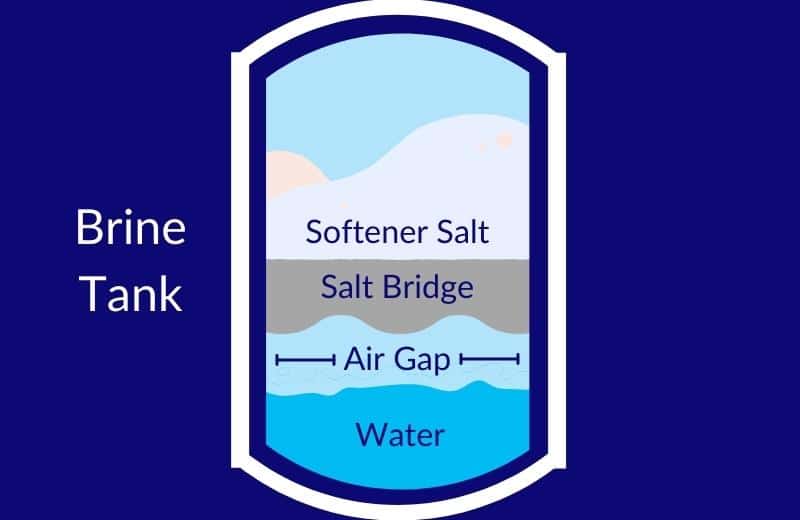
2. Salt Mushing
Salt bridging and salt mushing are often confused as the same thing, but although they’re equally common, they’re separate problems.
Salt mushing occurs in the bottom of the tank, and is caused by salt recrystallizing and forming sludge.
Salt mush blocks the base of the tank and prevents the brine solution from passing into the resin tank. This affects both the softening and regeneration processes. If you seem to no longer have soft water, salt mushing is one of the first problems to look for.
To fix a salt mushing issue, empty the water out of the brine tank entirely and remove the salt. Scrub the inside of the tank to remove leftover salt crystals, then add a fresh batch of salt.
3. Too Much Water in the Brine Tank
A water softener brine tank is supposed to contain water – that’s what dissolves the salt to form a brine solution.
However, one of the most common water softener problems is too much water in the brine tank. If your tank’s water is alarmingly high, or – even worse – overflowing, here are the likely reasons why:
Your Float Valve is Set Too High
This is the easiest and least threatening problem to resolve. The brine tank’s float valve controls how much water is in the tank at any time. To amend a float tank that’s too high, follow the instructions in your user manual to set the float valve to a lower level.
Your Water Softener is Old
An old water softener system may degrade to such a point that its components can’t do their jobs properly. This could cause too much water to enter the tank. If your softener is more than 8 years old, you might need to buy a new one altogether.
Your Water Entry Valve isn’t Working
A broken water entry valve is the worst cause of water in a brine tank, as it often leads to flooding. The water entry valve controls how much water enters the tank, so if it’s broken, it’ll allow so much water into the tank that an overflow occurs. Replace the valve to solve the issue.
Related: Why is my water softener overflowing?
4. Not Enough Water in the Brine Tank
Perhaps too much water isn’t one of the water softener problems you’re dealing with – perhaps your brine tank doesn’t have enough water.
This might not actually be a problem for you. It’s normal not to notice the water in the brine tank at all. But if your tank is only about half full of salt, and you still can’t see any water, here’s what might have happened:
The Brine Line is Clogged
The brine line is a tube connected to the brine tank, which refills the tank with water during the regeneration process. If this line becomes clogged or damaged, it may not send water into the tank as intended. Replace the brine line if the issue can’t be resolved by flushing the line.
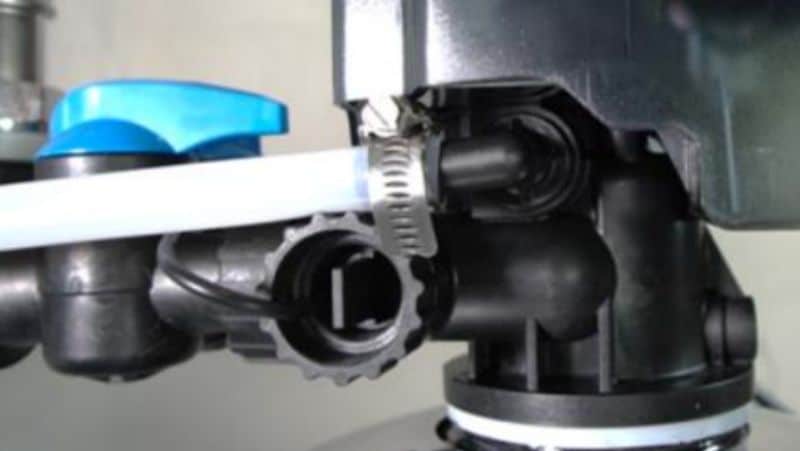
Your Float Valve is Set Too Low
Just as the float valve can be set too high, it can also be set too low, preventing enough water from getting into the tank. In this case, follow the instructions in the user manual to raise the float valve to a higher setting.
Your Water Entry Valve isn’t Working
Again, the water entry valve might be to blame here. Just as a broken valve can let too much water into the brine tank, it could also prevent water from entering the tank altogether. Replace the entry valve if necessary.
5. The Water Softener Isn’t Using Salt
If your water softener isn’t using salt, you might have a problem with the entry valve motor. This motor is supposed to control the amount of water that enters the brine tank.
If not enough water is getting into the tank, the salt won’t be able to dissolve in the water, and no brine will be formed.
Fix this issue by replacing the entry valve motor.
Note: A lot of people assume that their water softener isn’t using salt when it actually is. Remember it’s common for brine tanks to form salt bridges. A salt bridge occurs on the top of the existing salt, so you won’t notice when the salt beneath this layer is being used. Remove the bridge to reveal the true salt level in your brine tank.
6. Your Soft Water Contains Floating Particles
Floating particles in your soft water are a likely sign that your water softener’s resin beads are reaching the end of their lifespan.
Old resin beads are likely to break off from the resin bed and pass into the softened water itself. They’re not dangerous to drink in small quantities, but they’re a sign they need to take action and replace your resin.
New resin beads usually cost around $170 for a full tank’s worth. You can replace the resin beads yourself – just tip the old ones out and pour the new ones in their place.
7. Your Soft Water Tastes Salty
Although traditional water softeners do add salt to water, you shouldn’t be able to taste this salt. Salty water is a sign of a problem with your water softener.
One of the most simple-to-resolve causes of salty water is incorrect settings. Your water softener adds a measured amount of salt to your water based on your inputted water hardness. If you’ve inputted a number that’s too high, the system might add too much salt to your water.
A pinched drain hose presents another way for too much salt to get into your soft water. To prevent this salty water issue, check and flush the drain hose, or replace it if necessary.
8. Your Soft Water is Brown
This is one of the most worrying water softener problems to have. You want your water softener to improve your water quality – so why is your soft water brown?
Luckily, brown water is very rarely caused by a water softener itself. Most likely, the brown water leaving your faucets is caused by high sediment levels in your water source or by old, corroded plumbing in your home.
Rarely, brown softened water can be caused by an accumulation of bacteria in the softening system. If you’re not sure of the cause of your brown water, it won’t hurt to sterilize your softener to eliminate any potential bacteria buildup.
You can safely use bleach in a water softener brine tank – just add 2 ounces of bleach to every 3 gallons of water. Run several regeneration cycles, then allow water to flush out of your faucets for five minutes. If your water is still brown, test your water for sediment or call a plumber to inspect your pipes.
9. Your Water Softener Won’t Regenerate
Another of the most common water softener problems relates to regeneration. A correctly functioning softener performs a regeneration cycle at least once every two weeks.
If your system isn’t regenerating, it won’t be long before your access to soft water cuts off entirely – so you need to troubleshoot the problem ASAP.
Broken Regeneration Timer
One of the simplest (and thankfully easiest-to-fix) causes of a water softener that won’t regenerate is a broken regeneration timer. The regeneration timer programs the system to perform a regeneration cycle on a recurring basis. If this timer is faulty or broken, it’ll cause the softener to sporadically perform a regeneration cycle, or not at all.
To check for a broken regeneration timer, set the timer to a specific time, then listen for the softener to perform a regeneration cycle at this time. If it doesn’t, the timer is likely at fault, and you should replace it.
Clogging in the Tubes
Clogging in the tubes is another common issue in water softeners that can affect the frequency of regenerations. In this case, you may hear noises to suggest that your softener is performing a regeneration cycle, but your water might not taste soft – or it might taste too salty.
Remove the tubes and flush them, then replace them and set your softener to perform a manual regeneration cycle to see if the issue is resolved.
10. Your Water Softener is Making Unusual Noises
It’s right to be concerned if your water softener is making unusual noises, as this can be a sign that the system isn’t operating properly.
Loud clunking or whirring sounds indicate that one or several of the components in your softener are clogged, worn, or broken.
Examine the valves and water lines, and check the timer, motors, and air valves. If any of these parts are clogged, broken, or damaged, flush or replace them as necessary.
Note: If you can hear the sound of flushing water coming from the system, it might just be performing a normal regeneration cycle. In this case, it’s all fine! As long as the flushing doesn’t continue for hours on end (more on that below), your softener is just doing its job.
11. Your Water Softener is Stuck in Regeneration Cycles
The average length of a water softener regeneration cycle is two hours. If your water softener is performing regeneration cycles that are much longer than this, or it’s performing too-frequent regeneration cycles, it’s a sign of a problem with the system.
Clogged Water Line
If the pipe connecting the salt tank to the resin tank is clogged, brine won’t be able to pass into the resin bed. The softener will constantly try to draw brine from the tank, but will be unable to, resulting in a never ending regeneration cycle. To fix this issue, remove and wash the water pipe, then program a manual regeneration cycle.
Incorrect Settings or Broken Switches
Water softeners are smart machines, but because they’re computer-based, the smallest issue can prevent them from operating properly. Check that the system’s settings are still correct and that there are no broken switches. Amend the settings and fix or replace the switches as necessary.
Low Water Pressure
This issue isn’t so much to do with the water softener, but with your own water supply. If your water pressure is too low, it could prevent the softener from being able to properly regenerate, resulting in a stuck regeneration cycle. In this case, install a booster pump upstream of the softener to increase water flow into the system.
Related: Can a water softener cause low water pressure?
12. Your Water Softener is Leaking
Of all the problems to have with water softeners, leaking is one of the worst – and potentially the most catastrophic.
If you notice a puddle of water beneath your water softener, your first step is to find out where the leak is coming from. Check all the connections between the tanks, water pipes, and other parts.
You’re most likely to detect a leak immediately after installing a water softener or performing water softener maintenance. In this case, the problem is caused by incorrect installation. Tightening the fittings should help.
Leaking may also be caused by worn parts. Replacing the parts should resolve the issue.
If you’re dealing with a major leak, shut off your water supply as soon as you can and call a plumber to help you detect the problem.
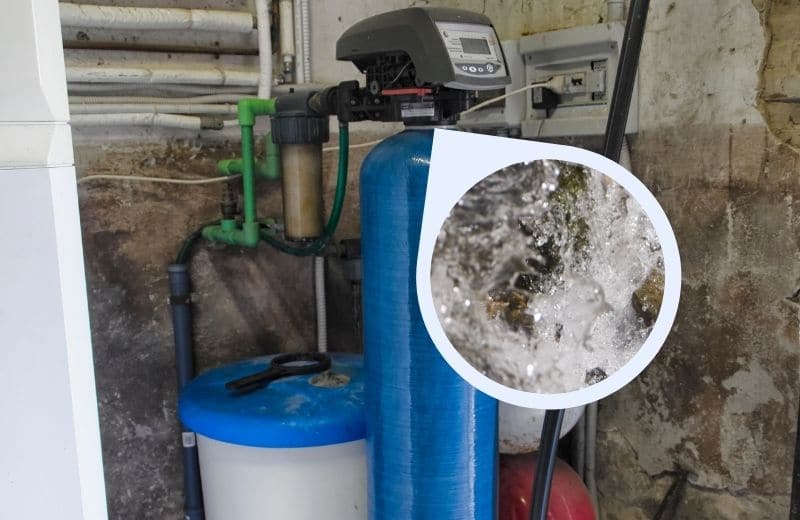
13. Your Water Softer is Set Up Incorrectly
There’s a lot that goes into setting up a water softener for the first time, and a lot of potential mistakes to make.
Your user manual should clearly outline exactly what you need to do to correctly set up your water softener, but this isn’t always the case. Or, your user manual might be clear enough, but you’re still confused by the setup process.
If you’re not sure how to set up your water softener, it’s worth calling the manufacturer and asking a customer service specialist to talk you through the process. If you’re still uncertain, contact your local plumber for professional assistance.
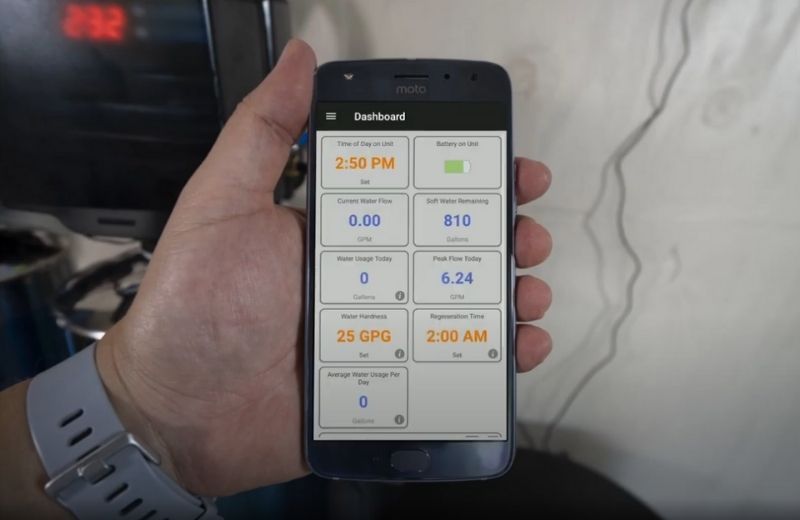
14. Your Water Softener has Died
A dead water softener sounds dramatic – but don’t worry, it isn’t the end for the entire system.
If your softener doesn’t appear to be doing much at all, first check that it’s plugged in and switched on. If it is, but it’s still not working, it’s likely due to motor failure. A failed motor means that the system can’t regenerate or perform any of the essential processes to keep operating.
If your cables and water lines are still intact but the motor won’t start, motor failure is the most likely cause. You may be able to replace the motor for free if you’re still within the warranty period. Otherwise, you’ll need to pay out of pocket for a new motor.
Repairing or replacing the motor is one of the most expensive jobs, so consider whether it may be time for a new water softener altogether.
15. Your Water Softener is Reducing your Water Pressure
Reduced water pressure in your plumbing system may be caused by your water softener for one of the following reasons:
Incorrectly Sized System
If your water softener is too small, it won’t be designed to provide the water flow that your plumbing system needs. There’s nothing you can do about this – if your water softener’s maximum pressure output is too low for your home, you’ll have to replace it with a correctly-sized system.
Clogged Resin
The resin bed itself can be the cause of reduced water pressure. As the resin ages, resin beads that are flushed down the drain line may cause a blockage, reducing the flow of water out of the system.
Iron or Sediment Buildup
Iron, sediment, and scaling in any part of the water softener can reduce water pressure. As water flows through the unit, it meets resistance from the built-up contaminants. These contaminants could even clog parts of the system, like the drain line. Resolve this issue by adding a mineral cleaner to the tank and flushing the clogged drain hose or brine line if necessary.
16. Your Water Isn’t Soft
The purpose of a water softener is to prevent hardness minerals from getting into your plumbing system. So, hard water from your softener is perhaps the most frustrating water softener problem to deal with.
Salt Buildup & Clogging
A salt build-up in the salt tank is one of the main causes of water that isn’t soft. Clogging and blockages can also prevent the system from doing its job of softening water.
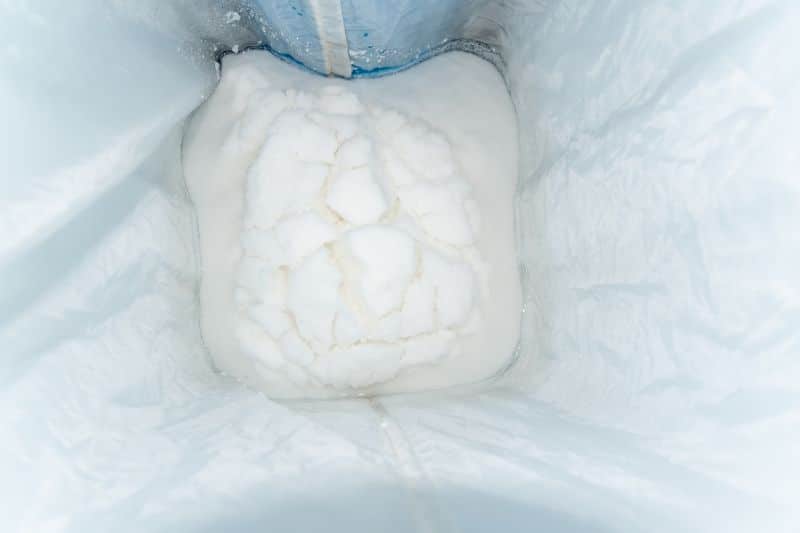
Activated Bypass Valve
Another potential problem is that the bypass valve is turned to divert water away from the system. In this case, you just need to turn the bypass valve so water is sent into the softener.
Excessive Softened Water Demand
Your demand for softened water might be too high for the system’s capacity, resulting in improper regeneration of the beads in the resin tank. This would mean that only some of your water was being softened.
17. Your Brine Tank is Clogged with Dirt
Dirt, sediment, and other unwanted matter can build up in the brine tank if impure salt, like rock salt, is used in the tank.
You’ll need to clean out the tank every 6-12 months to prevent dirt and sediment from causing a blockage. Follow our instructions on how to clean a water softener salt tank here.
The best way to prevent dirt in the salt tank is to not use dirty salt. Instead, use high-purity salt, like evaporated salt pellets.
Related:
📝 How to Diagnose and Fix Water Softener Problems: Step by Step
Now you have a manual of potential problems to access, the next step is to figure out which of these problems is affecting your softener.
Here’s the step-by-step process for diagnosing and fixing problems in most water softeners:
What You’ll Need:
- A bucket
- A water-safe vacuum cleaner
- A 4-in-1 screwdriver
What To Do:
- Check the Water Softener’s Power – Unplugging a water softener is easily done. Most water softeners need electricity to perform regenerations between softening cycles, and they won’t work if the power is off.
- Check the Softener’s Bypass Switch or Valve – Before you blame your water softener itself, problems with your water supply might be because water isn’t running through the softener in the first place. Check the bypass switch or valve on the top of the water softener to make sure that water is flowing through the system correctly.
- Consult the User Manual – The user manual will tell you all the important information you need to know about maintaining the softener, including when the resin beads need replacing and cleaning. Follow the instructions to replace or clean the resin bed.
- Check the Regeneration Timer – If the softener isn’t regenerating as normal, check the regeneration timer. Replace the timer if it’s faulty.
- Check for Broken Air Valves – A broken air valve causes air discharge after the softener has regenerated. Check the valves and replace them if they’re broken.
- Unclog Clogged Valves and Water Feed Lines – Check that the drain flow line, the brine tube, and the brine tank itself aren’t clogged, and flush them if they are.
- Replace the Salt – If a salt crust or a salt mush has formed in the brine tank, replacing the salt is the smartest solution.
- Reprogram or replace the control valve – In the case of a faulty control valve, reprogram or replace the valve. Your softener’s control valve should be covered by a warranty, so check to see if you’re still in the warranty period before paying out of pocket.
- Check salt dose setting – Excessive salt usage is likely caused by an incorrect salt done setting or clogs in the brine tank. Check for these issues and amend them as necessary.
- Disinfect the system – Finally, clean out the system following the manufacturer’s instructions.
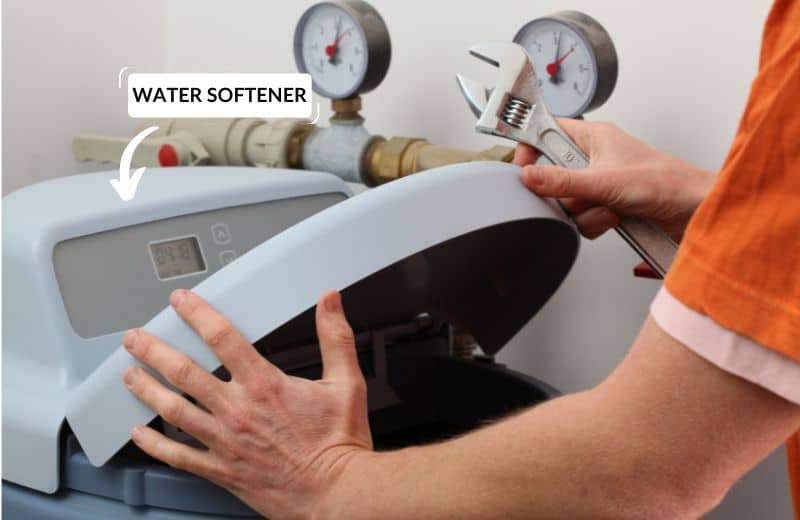
🪛 Common Water Softener Brand Problems & How to Resolve Them
Got a popular branded water softener that’s experiencing a problem? More than likely, other people have experienced this exact issue too.
Even the best water softeners are known to have their flaws. Here, we’ll be looking at some of the most common problems experienced by popular water softener brands, and how to fix them.
Whirlpool Water Softeners
The most common Whirlpool water softener problem is too much water in the brine tank. This is usually caused by a faulty or damaged rubber gasket.
To resolve the issue, follow these steps:
- Order a new rubber gasket and wait for it to arrive.
- Switch off and unplug your water softener, set the system to bypass mode, and remove all the salt from the brine tank.
- Disassemble the nozzle on the top of the water softener tank, then remove the damaged gasket and replace it with the new one. Reassemble the nozzle.
- Plug in and switch on the system. Program the softener to run a cycle – but don’t add salt to the tank yet. You need to see that the brine tank is no longer excessively filling with salt.
- If only about 2.5 inches of water has entered the tank, the problem is solved. Pour out the water and refill the brine tank with salt as normal.
Culligan Water Softeners
Low water pressure and constantly draining water are two of the most common issues you’ll experience with a Culligan water softener.
To fix low water pressure:
- Put the softener in bypass mode to see what your water pressure is like when it isn’t flowing through the system. You might have an issue with your water pressure that has nothing to do with your water softener. If so, consider installing a booster pump.
- If your water pressure is normal, check that the water softener is correctly sized for your water usage.
- If it is, check that the sediment filter isn’t clogged and ready for a replacement.
- Finally, check whether the resin beads are clogged. If they are, use a resin cleaner to clean them out, and replace them if necessary.
To fix constantly draining water:
If you can hear trickling water that doesn’t stop, it’s a sign that your water softener is stuck in regeneration mode. Switch on the bypass valve and consult our above guide on how to fix a water softener that’s constantly regenerating. Otherwise, call Culligan customer support.
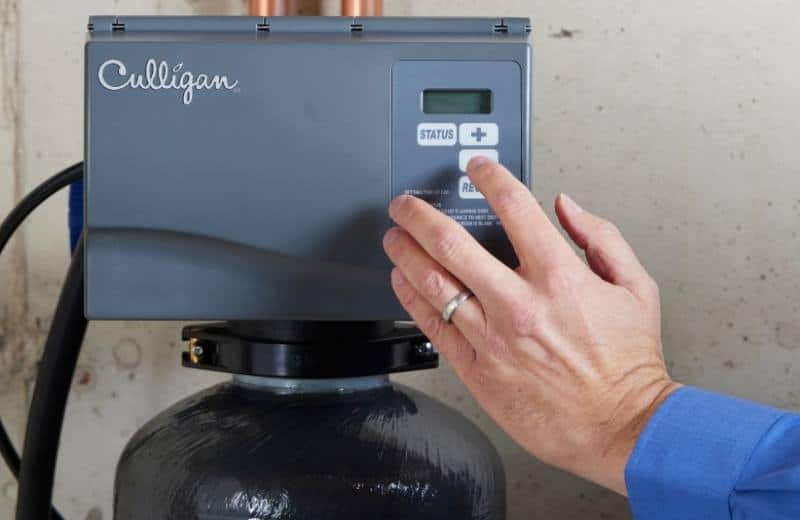
GE Water Softeners
You’re likely to come across two common issues with GE water softeners: error codes and control panel buttons not working.
To fix error codes:
- Bring out your user manual. This will tell you what all the error codes mean and how to resolve them.
- If you’ve lost your user manual or you just want more information, call GE’s customer service team for direct support.
To fix control panel buttons not working:
- Make sure the water softener is plugged in and switched on. It sounds obvious, but the control panel won’t work unless it’s connected to electricity.
- If the softener is switched on, but the buttons are unresponsive, you likely need a new clip for the touchpad. Order a new clip from the manufacturer.
- Replace the clip and try the buttons. If they’re still not working, replace the nozzle and the gasket.
- Seek help from GE’s customer support if the system’s control panel is still unresponsive.
SpringWell Water Softeners
Low water pressure and leaking are two common problems experienced by SpringWell water softener owners.
To fix low water pressure:
- Put the softener in bypass mode and check your own water pressure. If it’s low when water isn’t running through the softener, you might need to adjust your home’s pressure gauge or install a booster pump.
- If your water pressure is fine except for when water flows through the softener, check the sediment filter to see if it’s clogged and needs to be replaced.
- Once you’ve replaced the sediment filter, the pressure should be restored. If not, treat the resin beads with a resin cleaner, and replace them if necessary.
To fix leaking:
- Check the o-rings and connections in the system. Most leaking issues occur from incorrect installation or worn o-rings.
- Replace the o-rings if necessary. Hand-tighten connections and fittings if necessary.
- SpringWell’s softeners use high-quality components, so this should resolve the leaking issue. If not, call SpringWell customer support.

🚫 How to Prevent Water Softener Problems and Prolong your System’s Lifespan
Water softeners don’t last forever, but there are things you can do to maintain your softener and prevent it from dying an early death:
- Use high-quality salt – Highly pure salt like dissolved salt pellets are much cleaner for your water softener than impure salt like rock salt. This will reduce the cleaning involved in owning a water softener.
- Keep an eye out for clogging and salt bridges – You should quickly get into a routine of adding salt to your water softener, and get a good understanding of how much should be added, when. If your salt isn’t emptying as it usually does, check for a salt bridge or a clog at the bottom of the tank.
- Clean the resin tank when recommended – Your manufacturer should recommend a frequency for cleaning the resin tank, and which products to use. Resin bed cleaners are more potent than the water that’s used to flush the resin tank during regeneration, which helps to extend the resin’s lifespan.
- Don’t forget about the Venturi valve – Your water softener’s venturi valve sends the brine solution from the salt tank to the resin bed when the system regenerates. Regularly clean and inspect the Venturi valve for damage and replace it if necessary to prevent a loss of water pressure.
🧠 Water Softener Problems FAQs
How can you tell if your water softener is clogged?
The best way to tell that you have a clogged softener is if your water’s hardness level changes. If you start to notice hard water issues again, you might have a clog in the system.
What can go wrong with a water softener?
The most common things to go wrong with a water softening system are constant draining, too much water in the brine tank, salt bridges and mushing, sediment build up in the salt tank, and clogged resin.
Should there be water in the salt tank of a water softener?
Yes, but you should be able to see the water unless the tank is less than half full of salt. If you can see the water, you probably have a stuck float or a similar issue that’s causing too much water to enter the tank.
What happens when water softener stops working?
Depending on the issue, you could end up with hard water or water with a salty taste as a result of your softener not working.
How can you tell if a water softener is working?
If your water softening system is working, you’ll no longer have hard water in your home. You should also hear the softener regenerating when it’s scheduled to do so, and the softener’s output pressure should be the same as your usual water pressure.
How do you unclog a brine tank?
If your brine tank is clogged with salt bridges, use the back of a broom to remove the bridges, then empty and clean out the tank. Refill the salt and set the system to manually regenerate to ensure it’s working properly.


have soft water in kitchen but my bathtub turns rust color after a shower why?
Sounds like ferrous iron. Do you have a whole house water softener? Or are you softening just your kitchen water with a point of use system?
Whirlpool water softener WHES30 nothing happening. Replaced control panel, but nothing happening. contractor came out yesterday said not getting power to unit. Unit is still under warranty.
I’d recommend reaching out to Whirlpool directly for help resolving the issue under warranty. Here is their contact page https://www.whirlpool.com/services/contact-us.html
Control panel not working lighting up. GXSF30V 02. We have already installed a new control panel, but still not working. Power to the unit is ok
I have a water softener installed upstairs the water is soft but in the basement, there is no soft water, do I need a separate line installed in the basement?
Is there pressure in the basement? What you describe sounds like the water in the basement is bypassing the water softener altogether.
I am having black looking sand (balls) coming out of my spigots then it clears. I had my system worked on by someone who hooked up the in and out backwards on my water softener . Could this have caused my problem or how can I tell if my resin bed tank is leaking.Lady at the city water dept said the little balls look like resin !
HELP
It very well could be resin that escaped into the plumbing system – except resin is normally yellowish/ gold. Black sounds more like activated carbon fines. Do you have a filtration system in addition to the softener?
I’m getting a black grit or silty look residue in my toilets and out of faucets. Would this come from my filtration system? The filter is installed before my water softener. So it’s the filter then the water softener
What type of filter is it that’s installed upstream of the softener? Is it a tank-based system, or cartridge? What type of media does it use? Have you had your water tested by a lab? Is it city water or well water?